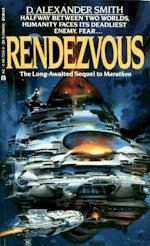 Continuing our tribute to Algis Budrys (1931-2008), the Book of the Week is his first novel, False Night, published by Lion Books in 1954. Like all of Budrys's early books, False Night was a paperback original. Because Lion Books was a small publisher (whom BOTW devotees may recall for its early edition of Frankenstein ), this edition has become hard to find. Even harder to find, however, is the revised edition published under the title Some Will Not Die, next week's Book of the Week.
Continuing our tribute to Algis Budrys (1931-2008), the Book of the Week is his first novel, False Night, published by Lion Books in 1954. Like all of Budrys's early books, False Night was a paperback original. Because Lion Books was a small publisher (whom BOTW devotees may recall for its early edition of Frankenstein ), this edition has become hard to find. Even harder to find, however, is the revised edition published under the title Some Will Not Die, next week's Book of the Week.False Night / Some Will Not Die is a post-apocalyptic tale set after most of America's population has been wiped out by a plague. In its bleak and gritty approach to this subject matter, the novel prefigured Cormac McCarthy's recent Pulitzer Prize winner The Road, published over 50 years later. Of course, False Night is science fiction and The Road is not, for reasons that will make sense to you if you squint really hard and slap yourself sharply across the face three times.



